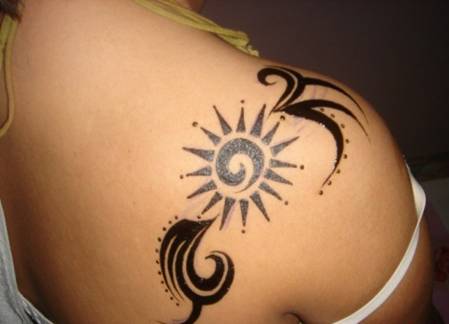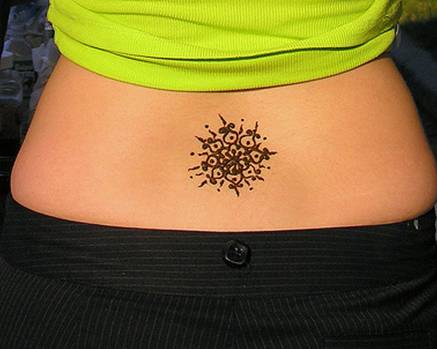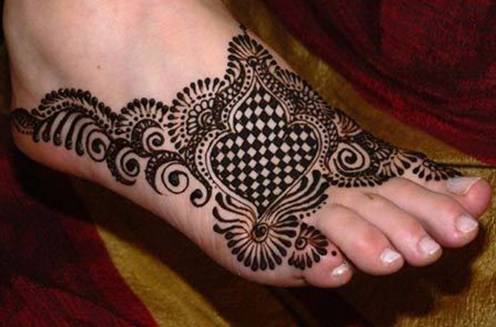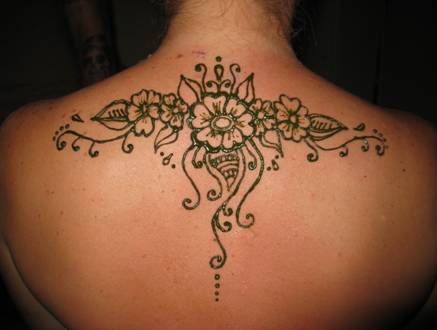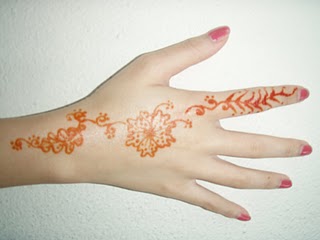Mehndi is the application of henna paste on the skin to get intrinsic designs and patterns on the various parts of the body. It is a body art usually done by women to adorn their body.The henna paste is made by crushing the henna leaves into fine powder.
Henna is commercially cultivated in western India, Iran, Pakistan, Afghanistan, Libya, Egypt, Morocoo, Yemen, Somalia and Bangladesh.
In India, Rajasthan is the most heavily cultivated henna production area. Henna has been used for body art and hair dye since the Bronze Age. Henna painting blossomed in India in the 12th century.

Henna powder color:
The mehndi powder can be a olive, green or dark brown colour, depending on its origin. It develops into a chocolate brown color when applied as a paste onto the skin. Fresh mehendi powder will produce a strong dark brown colour paste & will last longer. Stale mehndi will produce a light orange colour paste which will not get darker over time.
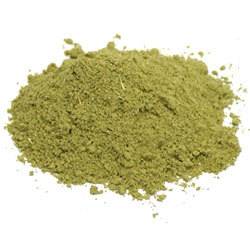
Henna uses:
Henna has many commercial and traditional uses. Henna paste is applied on the hands, palms and feet in various celebrations and festivals. It is used as a dye for hair, skin, fingernails, and preservative for leather and cloth. Henna leaves act as an anti-fungal and are placed along with clothes and leather products. Henna flowers are used to create perfume.
Henna is also known to have a cooling sensation to the skin, whether applied on the skin or hair. It also heals skin diseases.
Henna acts as a dye to color gray hair.
Leaves of other plants such as tea, coffee and tamarind are used to enhance the color and longevity of the henna design.
Henna used to color and condition the hair contains other ingredients mixed in it making it less refined. Henna used for body adornment is pure and filtered one. Henna that gives the brightest color is the most expensive one. It is finely ground, fresh, pure and soft.
Traditional usage of henna:
Henna is traditionally used for weddings and bridal preparations. It plays a very important role in Indian and other Asian weddings. Intricate designs and patterns of flowers, birds, geometric shapes, veins and paisley are applied on the hands, palms and feet of the bride in most cultures. It is believed, that the darker the color stains on the palms, the more loving is the partner. Not only the bride applies henna, all her friends and relatives also apply henna to be a part of the ceremony. In many cultures, even the groom applies mehndi on his palms. The designs however, are simple, basic and bold ones in this case.
Other traditional usage includes celebrations such as pregnancy, child birth, festivals, family get-togethers etc.
Women adorn themselves during auspicious celebrations, particularly marriage ceremonies with intricate henna patterns.
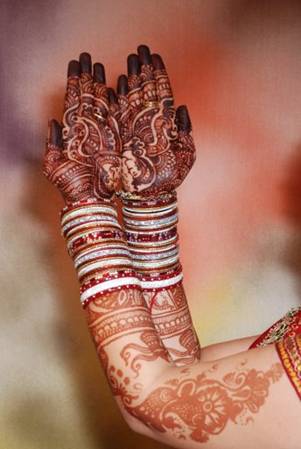
Henna color lasts for:
The mehndi designs can last anywhere from 4 days to 5 weeks, depending on the intensity of the stain on the skin and the aftercare.
Mehndi colors:
Henna stain ranges from light orange to red followed by maroon, brown and black. These colors can be achieved at different stages of the application and removal process.
Light orange: Henna left on the palms for only 2-3 hrs gives a light orange color.Washing the hands with soap and detergent immediately after removing the mehndi prevents further darkening of the color. Thus, the final output will be only an orange stain on the palms.
Red: Henna left on the palms for around 4 hours give a red color stain. It is important not to wash the hands immediately after removing the paste.
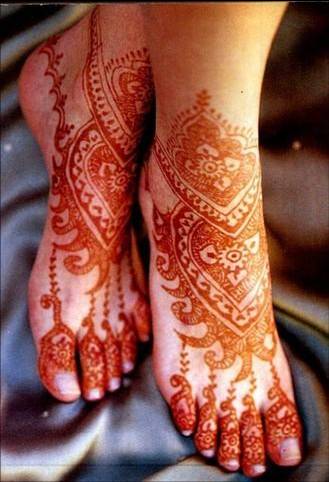
Brown: Henna left on the palms for 6 hours give a brown stain.One can also get the brown color by making a henna paste by adding tea water, coffee, or an additional dye. In this case, the paste can be removed in 2-3 hours.
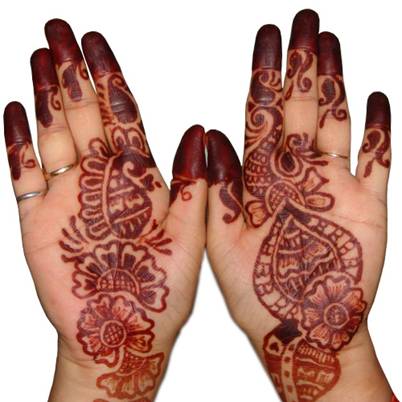
Black: Henna left on the palms for more than 6 hours give a black color stain. This color can also be achieved by mixing additional dye and color to the paste.
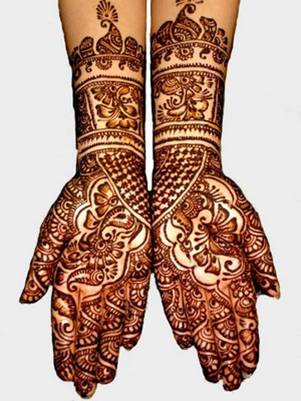
Mehndi design Categories:
Mehndi design varies from region to region and culture to culture. Various designs have different meaning for members of each culture, such as fertility, good health, protection, wisdom and spiritual enlightment.
Arabic mehndi pattern: Arabic henna patterns are usually large floral patterns applied on the hands and feet.
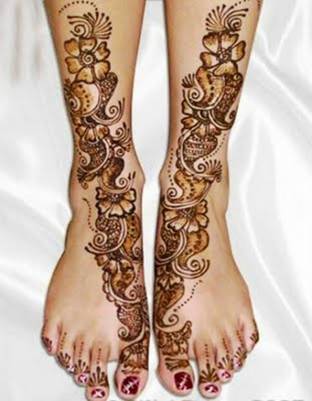
Marwadi mehndi pattern: The Marwari patterns are intrinsic thin patterns where the entire hand is filled without a single gap.
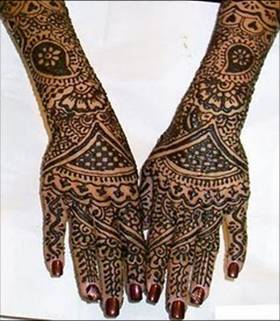
Sindhi mehndi pattern: The Sindhi pattern are big, elaborate and uniform patterns like only flowers or a big peacock starting from the palm and the feathers spreading till the wrist or extending towards the arms.
African mehndi pattern: These are large and bold geometric designs.
Indian and Pakistani traditional mehndi pattern involves fine, thin lines for lacy, floral and paisley patterns densely covering entire hands, forearms, feet and shins.
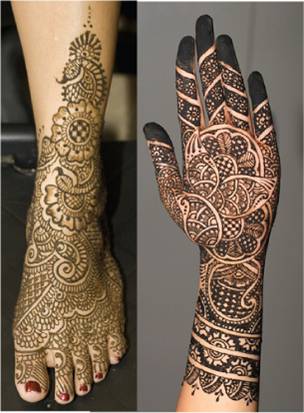
Mehndi design motifs:
The motifs comprise kalash, doli, peacocks, mangoes, parrots, paisley, flowers, veins, leaves, camels, marriage processions
Preparing the henna paste:
Henna stains only when the lawsone molecules are released from the henna leaf. Therefore, unbroken/ un-smashed henna leaves will not stain the skin.Coarse crushed leaves will stain the skin, but one may not be able to apply intricate designs with these leaves.
Commercially available henna powder is made by drying the henna leaves and crushing/milling them to powder. The powder is then sifted. This powder allows one to create intrinsic designs and patterns.
Making henna paste: Mix henna powder with tea water, lavender and lemon juice to get a fine paste. Allow the paste to rest for 6-12 hours. This allows the lawsone completely
dissolve in the paste.
Application of henna paste:
Mehndi can be applied onto the palms, hands, feet, shoulders, back or neck. Before applying mehndi, you must first wash your skin / area you wish to apply mehndi on.
Fill up the henna paste in a plastic cone with a pin hole opening at the tip. The opening should be big enough to allow a smooth flow of the henna paste to make the fine designs. Make sure not to cut the cone too big or else applying intrinsic designs would be difficult.
You can now apply desired patterns and designs by squeezing out the paste in a smooth and even manner. Keep the palm horizontal till the paste dries.
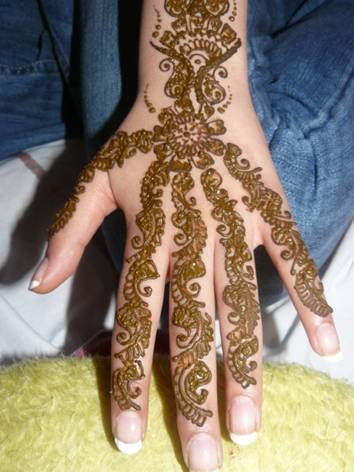
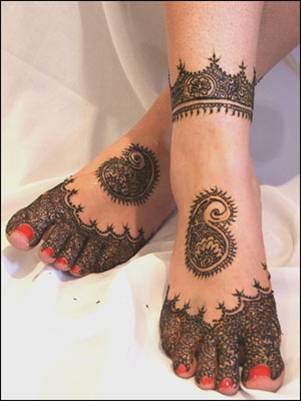
While drying, henna tends to crack and fall off the skin. It is therefore, often sealed down by dabbing a sugar/lemon mix over the dried paste, or simply adding some form of sugar to the paste. This also adds colour, increasing the intensity of the shade.
Mehndi gives off darker color when exposed to heat. It is therefore recommended to keep the paste as long as possible. Once the paste has dried completely, scrape it off gently with the help of a knife. The initial color mostly ranges from orange to red. The color gradually darkens with time. Avoid washing your hands for the first 8 hours to get a dark brown or black color stain.
Mehndi as a temporary body tattoo:
Henna also known as the Mehndi, is used to create temporary tattoos on the skin. It is agood alternative to permanent tattoos as they can be easily removed. Henna tattoos last for 3-4 weeks at the most. The paste is used to draw delicate patterns on the hands and feet, and can be applied in all sorts of designs anywhere on the body. The paste is allowed to stain and dry on the skin for few hours. Unlike other temporary tattoos, henna allows only limited range of colors like shades of reds, browns, and near-blacks.
